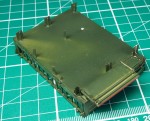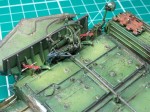1⁄35Military Model Emergency Room
4
Comments
Military Model ER
Being in a job where I move house every few years I’ve become a bit of an expert at repairing models. I once had an experience where all of my boxed models, which I had placed on the floor of the removal trailer, were moved between removal trucks at the depot – cue 2 months of repairs to models and dioramas after they arrived upside down! In this case the Legend/Tamiya VT-55 which I had built as a review sample reviewed here Live links took a dive after a MAFVA winners shield fell over and pushed it off the shelf. After a quick assessment I decided the damage was repairable (Pic 1). With my engineer head on I place damage into one of three categories: 1. Simple fix – part (or assembly) has broken off but is not damaged and can easily be reaffixed. 2. Complex fix – part is there, but is damaged and will need work to be repaired. 3. Beyond repair or missing – part is too damaged to attempt a repair or has been lost as a result of the incident.Carrying out the repairs
Looking around the VT-55 I noted the following damage: 1. Left track broken (Pic 2) – Category 1. 2. Front road wheel broken off (and second road wheel broken but still glued to track) (Pic 3) – Category 2. 3. Tooth broken and missing off of spade (Pic 4) – Category 3. 4. Spade loose and eventually broke off during repair (Pic 5) – Category 1. 5. Spade retaining turnbuckle broken and missing parts (Pic 6) – Category 3. 6. Commander broken off (Pic 7) – Category 1. 7. Bracket on commanders hatch broken off (Pic 7) – Category 3. 8. Rear tool hamper broken off and bracket broken – Category 1. 9. Crane and mount broken off – Category 1. 10. Antenna mount broken off and missing – Category 3. 11. Cable guide parts and cables broken (Pic 8) – Category 2. In assessing the individual repairs you also need to decide how to approach the overall repair – in this case it would be pointless trying to repair anything with the track flapping about; so the track repair needed to be the first thing tackled. The track couldn’t be fixed without the front and second road wheels being repaired – so this was the first job. The mounting arm was still attached to the hull in both cases but the wheel mounting rod was snapped inside the road wheels (Pic 9). The second road wheel was still glued to the track so I used a sharp scalpel blade to remove this. I drilled out the remnants of the mount on both ends and used piano wire to ensure a strong fix between the parts. I filled the gap with CA and also CA’d the lower track run in place to help with strengthening the joint (Pic 10 & 11). Once the joints had ‘gripped’ I reattached the ends of the broken track run and put this aside and allowed to dry (Pic 12). In the process of fixing the wheels and tracks the front spade, already partially broken fixings gave up the ghost and snapped off. After tidying up the broken tooth area I used thin plastic sheet to make a new tooth and attached with CA (Pic 13). On the real thing these are welded on so a clean fit isn’t required. I also remade the missing turnbuckle parts from brass tube and plastic sheet (Pic 14). I left this unfitted for now as once the front spade was refitted there would need to be some adjustment to get the correct length. Again, allowing the parts to dry I moved onto some of the easier fixes. The crane mount had broken off quite cleanly allowing it to be simply glued back into place. Once set I refitted the crane into its slot and attached with CA. The commanders hatch bracket was refitted and the missing antenna mount was replaced with a plastic part from the spares box (Pic 15). The small bracket was glued to the bottom of the tool hamper – This area is not visible on the finished model so I used a generous blob of CA here (Pic 16). With the track, wheels and spade now fixed I dry fitted the spade and pneumatic ram. Realising that it was going to be difficult to remove the spade and reaffix again I simply ran thin CA into all the spade fixing points and allowed to dry (Pic 17). Once set I reattached the turnbuckle parts. Moving onto the rear end I fixed the end of the very delicate cable guide and reattached the ‘electrical’ and pneumatic cables (Pic 18). With the tool hamper fixed I CA’d this back into place above the engine deck. With all other parts now fixed the Commander could be reattached to his complete AFV once again. I left the model for a few hours to dry before painting all parts in matt black acrylic. This ensures that any gloss from the CA used in the repairs is hidden. This dries quickly so I immediately used various acrylic colours to repaint all the repaired parts. To hide any subtle colour differences I also used an acrylic brown wash over these parts and added some chipping and gun metal highlights to tie in with the rest of the model (Pic 19). Overall the process to repair this model took about 3 hours and, unless you look closely (Pics 20 & 21) I don’t think you can tell that this model was once very damaged by a MAFVA shield! Original photo feature can be found here: Live linksComments
Moved to Texas from California almost 2 years ago, everytime I get up the courage to open one of my kit boxes I see these things..maybe this will help me set up an ER!
MAR 31, 2016 - 06:50 PM
Every time I transferred base either overseas or CONUS I had to ship completed kits. Most times I would box them up and mail them to my parents to store for me, but a few would go with me. And if you ever dealt with military shippers you know that "handle with care" is a myth. I would spend several days at my new units repairing damaged models. I was quite good at it but sometimes the kits were so damaged that all I could do was trash them which gave me an excuse to build another one.
APR 01, 2016 - 06:58 AM
Copyright ©2021 by Ian Barraclough. Images and/or videos also by copyright holder unless otherwise noted. The views and opinions expressed herein are solely the views and opinions of the authors and/or contributors to this Web site and do not necessarily represent the views and/or opinions of Armorama, KitMaker Network, or Silver Star Enterrpises. All rights reserved. Originally published on: 2016-03-31 13:51:30. Unique Reads: 13030































